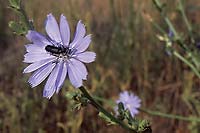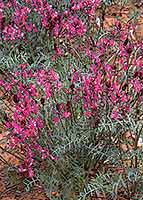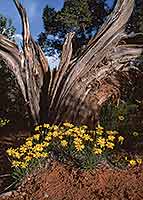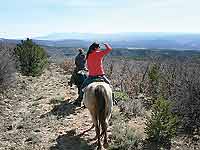|
|
 NATURE
HAPPENINGS May 2016 NATURE
HAPPENINGS May 2016
Flower Power
by Damian Fagan
Damian Fagan's blog |
Children of the 1960s might have a different definition of the term “flower power,” when non-violent ideology and passive resistant were forms of protest used against the Establishment. For me, the term also resonates with the amazing diversity and colorfulness of desert wildflowers and shrubs that bloom in a tough landscape under less than ideal conditions. Kind of like existing within a society that doesn’t share your views. 
But for now, we’ll talk nature not politics. The ancestry of desert lupines and beautiful monkeyflowers exceeds the mere spec of time that governments have existed when compared to plants that have existed for millions of years. Plus, the colorful blooms of cacti and pentsemon far outweigh the debates of politicians.
In springtime, the parade of wildflowers can starts early, sometimes in January with some hardy lomatiums peeking out from beneath protective rocks. Some weedy species gain traction in March, competing with Indian paintbrush, rockcress, twinpod and early locoweeds. These native plants tolerate the cold better than others which seems ironic considering this environment is known more for its intense summer heat than its short, winter cold.
 April is a wild card in the floral transition time zone and, depending upon the weather, can send the wildflower show into overdrive or keep it stuck in second gear. Hedgehog cacti bloom from the barrel-shaped cacti that grow in clusters or they remain covered with snow. You can count on Easter or cave primrose to bloom around Easter, and by one’s and two’s, other wildflowers poke up amongst the sandstone slabs. But if the weather is dry and cold, April’s wildflower display might be a no-show. April is a wild card in the floral transition time zone and, depending upon the weather, can send the wildflower show into overdrive or keep it stuck in second gear. Hedgehog cacti bloom from the barrel-shaped cacti that grow in clusters or they remain covered with snow. You can count on Easter or cave primrose to bloom around Easter, and by one’s and two’s, other wildflowers poke up amongst the sandstone slabs. But if the weather is dry and cold, April’s wildflower display might be a no-show.
Short of a drought, May is a good month to bet on the flowers erupting in color. Yucca wands of ghostly-white flowers light up the landscape and attract the nocturnal pronuba moths that pollinate the flowers. Hillsides may turn golden as beeplant or blanketflower erupt into bloom or orange globemallow burst open. There are the fine wildflower years, the memorable ones where every plant and shrub seems to be cloaked in color.
This bounty of flowers might seem spectacular enough, but when you consider that many seeds of these plants have lain dormant for years awaiting these conditions, it gives another level of awe to the display. And not to be outdone by colorful flowers and spectacular floral displays, is an ancient relationship between pollinators and plants.
 Butterflies, bees, ants, flies, beetles these and other insects assist flowers in transferring pollen from plant to plant. The insects gain nectar or pollen rewards for their loyalty or for just showing up. The flowers employ different strategies based upon structure and color. Probably the most amazing pollinator is found deep within the blooms of the prickly pear cactus. Amidst a waving sea of stamens bearing pollen are iridescent beetles mowing through the thickets. Butterflies, bees, ants, flies, beetles these and other insects assist flowers in transferring pollen from plant to plant. The insects gain nectar or pollen rewards for their loyalty or for just showing up. The flowers employ different strategies based upon structure and color. Probably the most amazing pollinator is found deep within the blooms of the prickly pear cactus. Amidst a waving sea of stamens bearing pollen are iridescent beetles mowing through the thickets.
Not to be outdone by the beetles, black-chinned hummingbirds also contribute to the flow of pollen from plant to plant. As they probe the tubular flowers of penstemon in search of nectar, their foreheads become dusted with pollen. Visiting another flower, they brush up against the flower’s female stigma and pollen grains are transferred. Future generations depend upon this coordination and choreography.
So what if a season goes by without success? A look into the seed bank buried in the vault of desert soil reveals this investment in the future. Tough, resilient, patient, these seeds await the right conditions before they germinate. Even in a poor year there is seed set and contributions to this seed bank that are deposited. After all, the success of the future depends upon the production of the present, and that cycle has been rotating through the Canyon Country for a long, long time, much to our delight.
| Damian Fagan is an accomplished writer who has published a number of guide books as well as numerous articles. If you would like to read more or find out what Damian is up to follow this link to Damian Fagan's blog. |
|
| Back by popular demand! For a limited time and at no additional charge: WILDFLOWERS! |
The record setting snowfall of our recent winter has dressed the La Sal Mountains in vegetation. Spring has been slightly delayed, but because of the extraordinary water year, we expect to see it last longer. The flats and hillsides east of Moab are flush with the early blooms common to the Pinon Juniper Forest, much to the benefit of foraging wild bees, moths, and butterflies.
Further up, at the elevation of our home base (about eight thousand feet), we are still waiting for the hummingbirds to return from their winter migrations, but already we can spot the first arrivals of Indian Paintbrush, Wild Clover, Lupine, Penstemen and many other more secretive, but not uncommon, flowering plants. As we move up again, say a thousand feet or so to the higher meadows, the Wild Iris’ are emerging, and soon the pale blue will carpet the ground and soften the view in the style of an impressionist painter. For me, the scene inspires a silent and satisfied smile and I can feel the step of my horse liven. I have no doubt she is enjoying it with me.
In a month we can move even higher, into the upper elevations where you can walk out of summer...and spring and further up...back into late winter, to elevations where the snow lets go of the rocky ground one meadow, or ridge...at a step. Soon the vegetation will explode in an urgency that betrays the shortness of the growing season. At this altitude the variety is spectacular! With the competition for space and the fleetness of spring, the flowers seem to cooperate with each other in a way not seen at lower elevations. Some of the varieties found in a warmer drier clime, such as lupine, also work their way up here to the alpine tundra where they crowd in with Wild Strawberry, Rock Columbine, Mountain Globemallow, and the singular La Sal Daisy.
Up here the water, released from its winter as ice, flows freely and invites one to sit and listen as it tumbles melodically towards the gathering streams, and on down to where the fractured soil of summer begs for a drink. But this time of year, I know, as the seed pods of the Wild Iris rattle against my horses legs, that the lower meadows, cool and moist before, will soon be frost by morning then dry as a cough by noon. It is then I invoke Indian Paint brush to make friends with Indian Summer and allow just a little more time for making memories, to be recalled later, when I will be a lonely sign of life, here…on a sleeping mountain.
Kevin Stowe operates guided horseback tours on the La Sal Mountains and may be contacted at RocknRidge.com
Please, be sure to mention you read about it in Moab Happenings.
|
|
|
|
|
|
© 2002-2024 Moab Happenings. All rights
reserved.
Reproduction of information contained in this site is
expressly prohibited.
|
|




 April is a wild card in the floral transition time zone and, depending upon the weather, can send the wildflower show into overdrive or keep it stuck in second gear. Hedgehog cacti bloom from the barrel-shaped cacti that grow in clusters or they remain covered with snow. You can count on Easter or cave primrose to bloom around Easter, and by one’s and two’s, other wildflowers poke up amongst the sandstone slabs. But if the weather is dry and cold, April’s wildflower display might be a no-show.
April is a wild card in the floral transition time zone and, depending upon the weather, can send the wildflower show into overdrive or keep it stuck in second gear. Hedgehog cacti bloom from the barrel-shaped cacti that grow in clusters or they remain covered with snow. You can count on Easter or cave primrose to bloom around Easter, and by one’s and two’s, other wildflowers poke up amongst the sandstone slabs. But if the weather is dry and cold, April’s wildflower display might be a no-show.  Butterflies, bees, ants, flies, beetles these and other insects assist flowers in transferring pollen from plant to plant. The insects gain nectar or pollen rewards for their loyalty or for just showing up. The flowers employ different strategies based upon structure and color. Probably the most amazing pollinator is found deep within the blooms of the prickly pear cactus. Amidst a waving sea of stamens bearing pollen are iridescent beetles mowing through the thickets.
Butterflies, bees, ants, flies, beetles these and other insects assist flowers in transferring pollen from plant to plant. The insects gain nectar or pollen rewards for their loyalty or for just showing up. The flowers employ different strategies based upon structure and color. Probably the most amazing pollinator is found deep within the blooms of the prickly pear cactus. Amidst a waving sea of stamens bearing pollen are iridescent beetles mowing through the thickets.